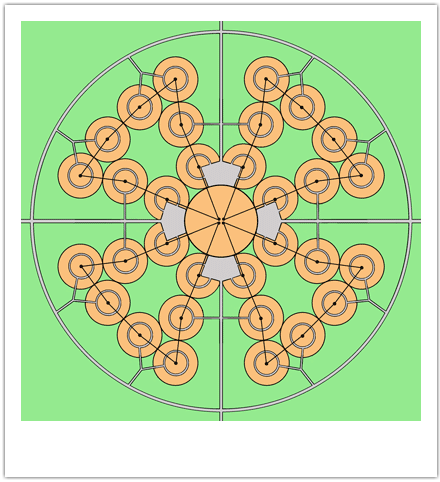Design
GreenEarthCity embraces the following concepts:
Resiliency and Regenerative
Resiliency is a key component to any development. Whether the design is an urban development or rural, developing food and energy independence are key components. Resilience is important in addressing climate change and economic instabilities. GEC team members will embrace concepts that integrate resiliency with local, county, state and federal laws, mandates and policies. Designs should be regenerative with a dedication to understanding micro-economics, geology, hydrology, social and natural ecosystems in a way that can heal and improve the land and communities.
Alternative energy sources and strategies :
Wind Power
Solar Power
Micro hydro
Conservation design and more.
Permaculture Design
Permacultural principles are a bedrock concept in our designs. We also realize that while nothing is actually permanent, we can consider ways integrate those principles into our plans.
Healthy Economics
If we're developing an ecovillage, we feel that creating viable jobs, and occupations within that community are as important as how the layouts, and designs are. Can a community produce what it needs? Can flows of revenue be shared within the community. What are the forms of ownership the community embrace?
GreenEarthCity (GEC) is about communication in action and creating a discussion for how a community should work to stay healthy. We feel that design should incorporate natural ecology, geology, human ecology, permaculture principles, and that a team of people can help facilitate the most appropriate design by also taking into account the needs of the community and the existing rules and regulations.
Examples:
Zocolos
Large free community centers
Communal ownership possibilities of land and services with membership in each community
Open buildings or rooms for neighborhood meetings
Transparent and open planning sessions
Kin Domains
With economy playing a large role in the viability of Ecocity development, it must be noted that to facilitate the creation of these developments economic theory must account for long term energy use, food production, true cost of the production impacts
Resiliency and Regenerative
Resiliency is a key component to any development. Whether the design is an urban development or rural, developing food and energy independence are key components. Resilience is important in addressing climate change and economic instabilities. GEC team members will embrace concepts that integrate resiliency with local, county, state and federal laws, mandates and policies. Designs should be regenerative with a dedication to understanding micro-economics, geology, hydrology, social and natural ecosystems in a way that can heal and improve the land and communities.
Alternative energy sources and strategies :
Wind Power
Solar Power
Micro hydro
Conservation design and more.
Permaculture Design
Permacultural principles are a bedrock concept in our designs. We also realize that while nothing is actually permanent, we can consider ways integrate those principles into our plans.
Healthy Economics
If we're developing an ecovillage, we feel that creating viable jobs, and occupations within that community are as important as how the layouts, and designs are. Can a community produce what it needs? Can flows of revenue be shared within the community. What are the forms of ownership the community embrace?
GreenEarthCity (GEC) is about communication in action and creating a discussion for how a community should work to stay healthy. We feel that design should incorporate natural ecology, geology, human ecology, permaculture principles, and that a team of people can help facilitate the most appropriate design by also taking into account the needs of the community and the existing rules and regulations.
Examples:
Zocolos
Large free community centers
Communal ownership possibilities of land and services with membership in each community
Open buildings or rooms for neighborhood meetings
Transparent and open planning sessions
Kin Domains
With economy playing a large role in the viability of Ecocity development, it must be noted that to facilitate the creation of these developments economic theory must account for long term energy use, food production, true cost of the production impacts

